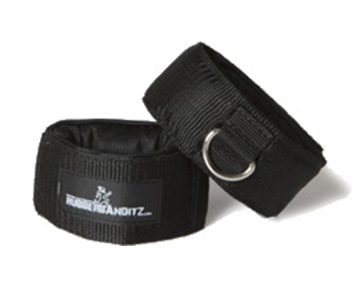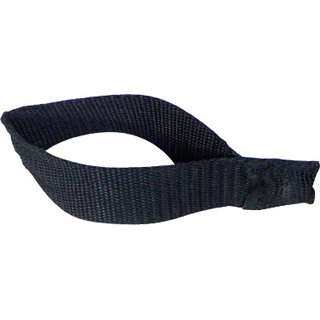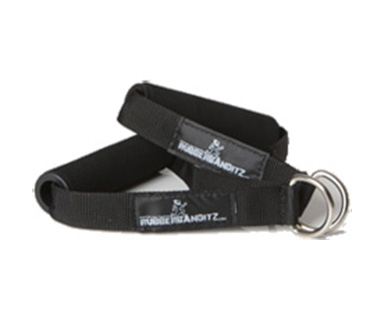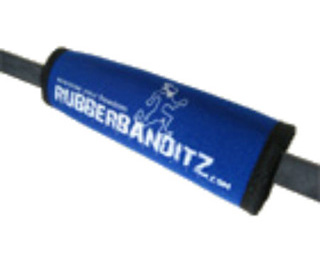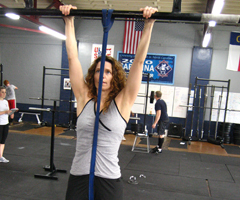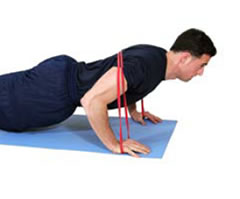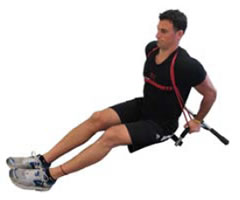The following terms will help you decipher how to perform the exercises in the manual. If you find that you still have uncertainties after reviewing this glossary or have any suggestions for other terms, please feel free to contact us.
Accessories
Ankle Grip
Cushioned attachments for the bands available for a more comfortable grip. Clip in and attach to band via carabiner. Click here to see the Ankle grip store page »
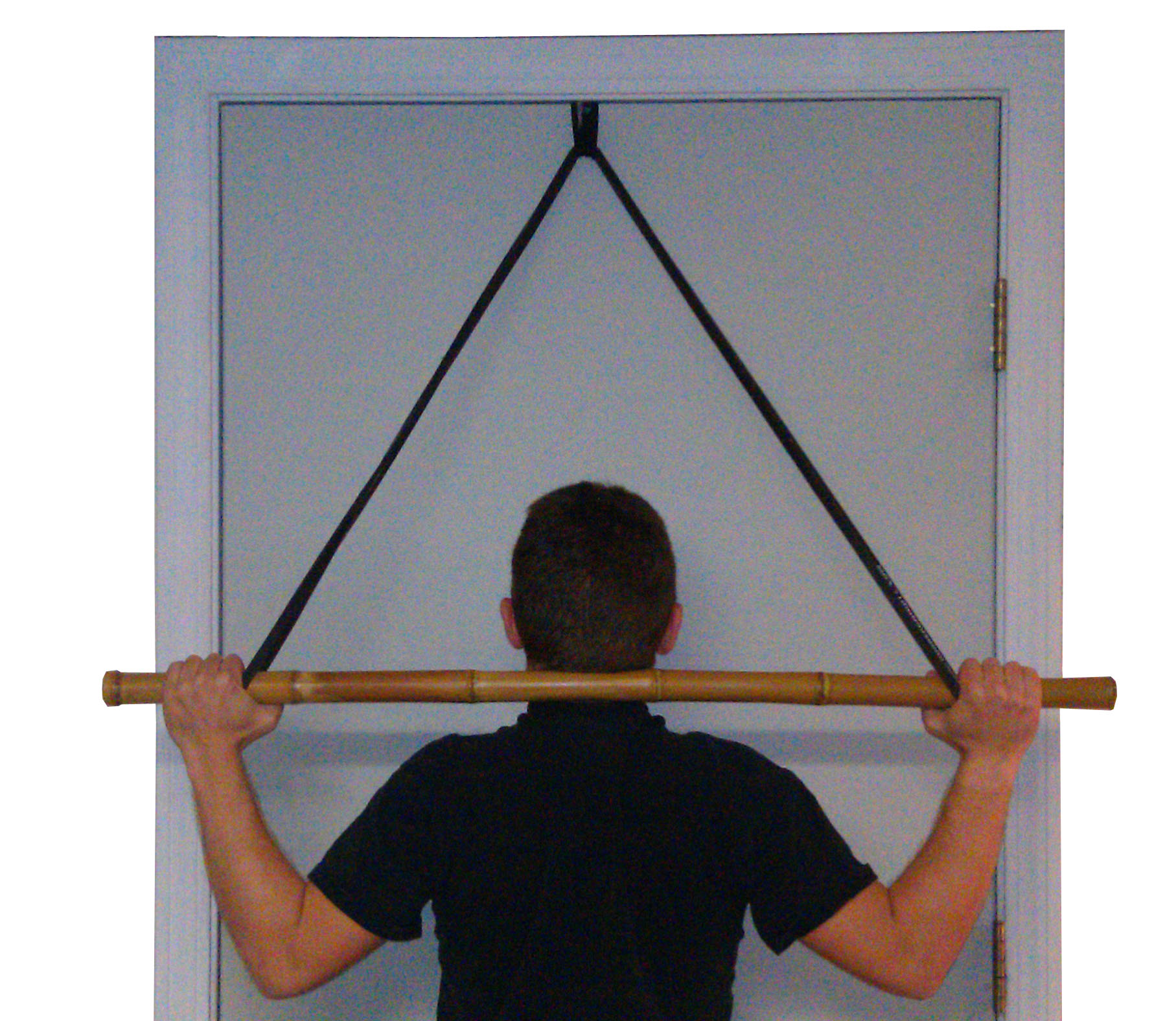
Bar / Stick
This can be anything that is straight and narrow enough to wrap your hands around. The material doesn´t matter as long as the weight of the item does not impede your ability to easily lift it. Examples may include, but are not limited to: broom or mop stick, tree branch, metal shaft, or a pole.
Door Strap
Open door and insert strap between door and frame. Then, close door and wrap or fasten band through strap. Adjust position anywhere between door and frame. Click here to see the Door Strap store page »
NOTE: Door strap is not recommended for use below doors, on hollow doors and where there is a wide gap between door and frame.
Hand Grip
Cushioned attachments for the bands available for a more comfortable grip. Clip in and attach to band via carabiner Click here to see Hand Grip store page »
Hand Strap
Join ends together around band(s) with Velcro strip. Use to prevent irritation between skin and band. Click here to see Hand Strap store page »
Compound Exercise – An exercise that requires more than one joint movement at a time to perform the lift. These exercises work various muscle groups at the same time and should be done often for strength development. In contrast, lifts that concentrate on one muscle group at a time are known as isolation exercises. Examples of compound exercises include (click to see the exercise info page):
Pull ups
Push ups
Fitness Terms
Anchor Point (A.P.)
The exact location where you wrap, stabilize, fasten, or loop a band to a fixed object. Adjusting the anchor point will normally result in a change of resistance: the further you are from the A.P., the higher the resistance, while the closer you are to the A.P., the lower the resistance.
Muscle Confusion
Continuously modifying your routines to prevent muscles plateaus (making minimal gains). Altering your routines periodically is very important. In addition to selecting different exercises, you can also modify the resistance and perform more or less reps accordingly. Integrating negatives, static contraction training, drop sets, and supersets are great ways to vary your workout.
Muscle Fatigue
(Also: failure, exhaustion)
The point in the set where you can’t lift an additional repetition without cheating. Upon reaching your point of exhaustion, you can always try and muster out partial reps, which are less than full range-of-motion repetitions.
Negatives
A controlled muscle resistance that involves fighting the regression portion of the exercise. In contrast to conventional repetitions, which normally begin at the easiest point before peaking (concentric movement) and then returning back to the easiest point (eccentric movement), negatives begin at the peak of the repetition (after the concentric movement) and slowly resist the retreat back to starting position (isometric movement). It has been suggested that this portion of the exercise stimulates the most muscle and is therefore responsible for the greatest growth.
Repititions (Reps)
The completion of one full motion called for by a particular exercise.
Routine
The group of exercises you perform in one workout.
General Terms
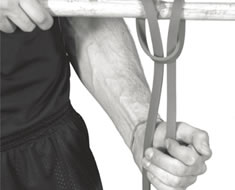
Wrap
To secure the middle of a band in place by doubling it around an object. Try to position the ends of the band as close together as possible to prevent them from slipping.
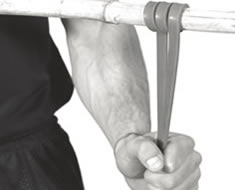
Stabilize
To secure one end of a band in place by inserting an object through to limit that side’s mobility.

Fasten
To secure one end of a band in place by circling the band around an object and then pulling one end through the other.
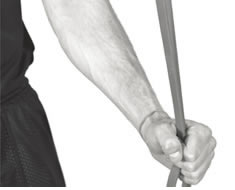
Loop
To circle the band around an object for the purpose of raising the resistance by shortening the band’s exposed length.
Holds – The option of wide, narrow, overhand, or underhand grips you can choose to use for any given exercise.
Grasp
A generic term meaning to, ¨hold the bar, handgrip, or band ends in your hand.
Ends
The part of the band that is convenient to grasp or insert an attachment to when the band is doubled over (we do recognize that circular bands have no true ends).
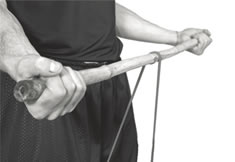
Wide Grip
Spacing your hands far apart when performing an exercise.
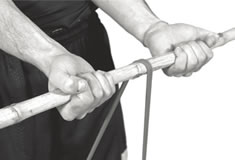
Narrow Grip
Spacing your hands close together when performing an exercise.
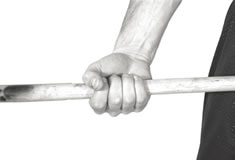
Underhand Grip
Grasping the BAR/STICK, handgrips, or band with your palms facing up.
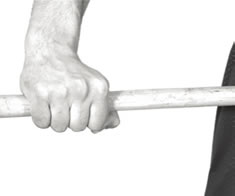
Overhand Grip
Grasping the BAR/STICK, handgrips, or band with your palms facing down.
Lift – The specific exercise you perform. This term is used interchangeable with "exercise." Examples of lifts are (click to see the exercise info page):
Bandbell Curl
Military Press
Post – This is a very broad term that encompasses anything you could attach a band to for the purpose of creating resistance on the opposite end. Examples may include, but are not limited to: your feet, back, a tree, bedpost, pillar, support beam, or your door strap. How and where you attach a band to a post is what determines your anchor point.
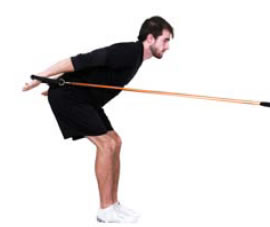
Front Post
A post located in front of you when performing a lift.
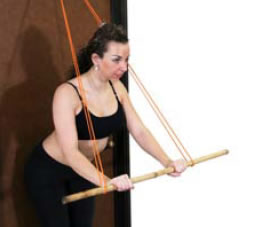
Overhead Post
A post located anywhere above your head when performing a lift.
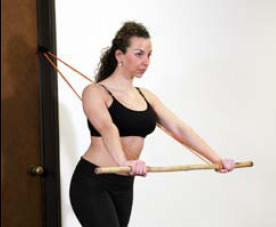
Rear Post
A post located behind you when performing a lift.
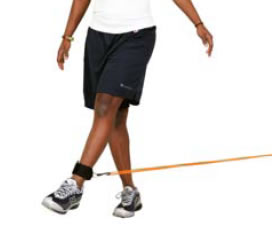
Side/Lateral Post
A post located at your side.
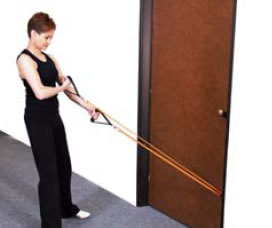
Low Post
A post located lower than your knees
Set – The amount of reps you do at one given time before resting.
Drop Set
A double set where you complete a full set, and then immediately lower the resistance to do a second “drop set” of the same lift to further exhaust your muscles.
Staggered Set
Sets of a non-related exercise or activity infused into your workout routine. Staggered sets can be anything you want to include in your workout such as: push-ups, pull-ups, stretching, yoga, core exercises, or homework. An additional bonus of working out with exercise bands is that you can spread out your workout over the course of a few hours if necessary. Short doses of exercise can be rewarding anytime, even if done intermittently between chapters, commercials, meetings, or traffic lights. Stagger exercise into life! Please note that American College of Sports Medicine (ACSM) advocates working out for at least 25 minutes for a true benefit.
Superset
Doing two different lifts for two different muscle groups back-to-back. For example, doing one set of a chest lift, and then immediately doing a set of bicep exercises before resting. While you are working out one muscle, the other muscle has time to rest and recover. This will keep up your workout intensity, speed up your workout, and leave your muscles exhausted afterwards. This is great for the split routines and circuit training routines.
Training Types
High-Intensity Training
An exercise philosophy we advocate that suggests exerting yourself by performing as many repetitions as you can until you reach failure in each set.
Static Isometric Contraction Training
Instead of performing a complete repetition, hold your rep at the point of maximum resistance until your muscles fatigue. These extended reps can be performed once or multiple times to make up a set. The difference between this and negatives, is that with static contraction you are holding the resistance in one place, whereas with negatives you are slowly retreating back to starting position.
Split Routines
These routines are designed to build muscle mass. Each muscle group is exercised more extensively in each routine but less frequently per week.
Try to superset all of your sets to maintain a high intensity, expedite your workout, and leave your muscles exhausted afterwards. Try to limit your rests to a quick breather only between sets after you have completed a superset.
Example:
- 1st set BENCH PRESS then without resting 1st set BANDBELL CURLS then
- 2nd set BENCH PRESS 2nd set BANDBELL CURLS then
- 3rd set BENCH PRESS 3rd set BANDBELL CURLS …
The split routines are designed so that while you are working out one of the focused muscle groups, the other is resting and should be fresh for every alternating set.
Raise the resistance and try for 8-10 reps per set to build muscle mass. If your objective is to maintain or tone your current muscle mass, lower the resistance and aim for 15-25 reps per set.


